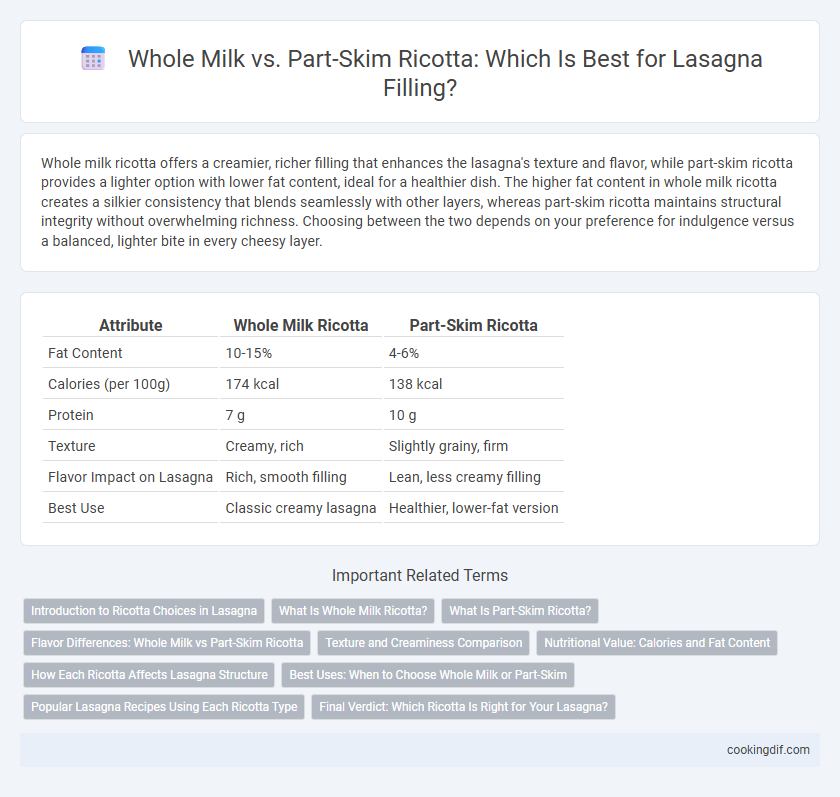Whole milk ricotta offers a creamier, richer filling that enhances the lasagna's texture and flavor, while part-skim ricotta provides a lighter option with lower fat content, ideal for a healthier dish. The higher fat content in whole milk ricotta creates a silkier consistency that blends seamlessly with other layers, whereas part-skim ricotta maintains structural integrity without overwhelming richness. Choosing between the two depends on your preference for indulgence versus a balanced, lighter bite in every cheesy layer.
Table of Comparison
| Attribute | Whole Milk Ricotta | Part-Skim Ricotta |
|---|---|---|
| Fat Content | 10-15% | 4-6% |
| Calories (per 100g) | 174 kcal | 138 kcal |
| Protein | 7 g | 10 g |
| Texture | Creamy, rich | Slightly grainy, firm |
| Flavor Impact on Lasagna | Rich, smooth filling | Lean, less creamy filling |
| Best Use | Classic creamy lasagna | Healthier, lower-fat version |
Introduction to Ricotta Choices in Lasagna
Whole milk ricotta offers a creamy, rich texture ideal for a luxurious lasagna filling, while part-skim ricotta provides a lighter, lower-fat alternative without sacrificing moisture. Selecting whole milk ricotta enhances the custard-like consistency, contributing to a more indulgent dish, whereas part-skim ricotta maintains structure and reduces overall calorie content. Both options deliver essential protein and calcium, but the choice depends on desired flavor intensity and nutritional preferences.
What Is Whole Milk Ricotta?
Whole milk ricotta is a creamy, rich cheese made from the whey of whole cow's milk, offering higher fat content that enhances the lasagna filling's texture and flavor. Unlike part-skim ricotta, it provides a smoother, more indulgent consistency, contributing to a moist and velvety layering inside the dish. Choosing whole milk ricotta results in a richer mouthfeel and a more authentic Italian lasagna experience.
What Is Part-Skim Ricotta?
Part-skim ricotta is a type of cheese made by removing some of the milk fat from whole milk before processing, resulting in a lower-fat option compared to whole milk ricotta. This cheese offers a lighter texture and reduced calorie count while still maintaining a creamy consistency ideal for lasagna fillings. Using part-skim ricotta in lasagna provides a balance between flavor and health-conscious choices without sacrificing the rich, cheesy taste crucial to the dish.
Flavor Differences: Whole Milk vs Part-Skim Ricotta
Whole milk ricotta offers a creamier texture and richer flavor due to its higher fat content, enhancing the lasagna filling's smoothness and depth. Part-skim ricotta provides a lighter, less creamy option with a milder taste, making it suitable for those seeking reduced fat without sacrificing texture entirely. Choosing whole milk ricotta intensifies the savory, luscious quality of the filling, while part-skim ricotta contributes a subtly tangy, airy element to the dish.
Texture and Creaminess Comparison
Whole milk ricotta provides a richer, creamier texture that enhances the lasagna filling's smoothness and moisture, creating a velvety mouthfeel. Part-skim ricotta, while leaner, results in a firmer, less creamy consistency, offering a lighter filling with reduced fat content. Choosing whole milk ricotta improves the overall creaminess and indulgence, whereas part-skim is preferred for a healthier, less dense texture.
Nutritional Value: Calories and Fat Content
Whole milk ricotta contains approximately 100 calories and 8 grams of fat per 1/4 cup serving, offering a richer, creamier texture ideal for lasagna filling. Part-skim ricotta reduces calories to about 70 and fat to 4.5 grams per 1/4 cup, providing a lighter alternative with lower saturated fat while maintaining adequate protein. Choosing whole milk ricotta increases overall calorie and fat content, enhancing flavor but impacting nutritional density in baked dishes.
How Each Ricotta Affects Lasagna Structure
Whole milk ricotta creates a creamier, richer lasagna filling that contributes to a denser texture and more cohesive layers. Part-skim ricotta offers a firmer structure with less moisture, preventing the lasagna from becoming too watery and helping it hold its shape when sliced. Selecting whole milk ricotta enhances smoothness and mouthfeel, while part-skim ricotta emphasizes stability and firmness in the final dish.
Best Uses: When to Choose Whole Milk or Part-Skim
Whole milk ricotta offers a creamier texture and richer flavor, ideal for luscious, indulgent lasagna recipes where moisture and decadence are priorities. Part-skim ricotta provides a lower fat option with a firmer consistency, perfect for lighter lasagna versions or when combining with other cheeses to balance textures. Choosing between whole milk and part-skim ricotta depends on desired richness and dietary preferences, with whole milk best for richness and part-skim for reduced fat without sacrificing structure.
Popular Lasagna Recipes Using Each Ricotta Type
Popular lasagna recipes featuring whole milk ricotta emphasize a rich, creamy filling that enhances traditional Italian flavors and creates a velvety texture. Part-skim ricotta is favored in lighter lasagna variations, offering a lower fat content while maintaining a mild, slightly tangy taste ideal for vegetable or lean meat versions. Both ricotta types influence the dish's moisture balance and mouthfeel, with whole milk yielding indulgent depth and part-skim providing a healthier, subtly firm consistency.
Final Verdict: Which Ricotta Is Right for Your Lasagna?
Whole milk ricotta delivers a creamier, richer texture ideal for decadent, indulgent lasagna, while part-skim ricotta offers a lighter, lower-fat alternative that maintains sufficient moisture and flavor. Preference depends on dietary goals and desired mouthfeel, with whole milk ricotta enhancing creaminess and part-skim ricotta providing a leaner filling. For a balanced approach, blending both types can achieve a satisfying consistency without compromising taste or health considerations.
Whole milk vs Part-skim ricotta for filling Infographic

 cookingdif.com
cookingdif.com